Health Program Planning and Implementation Research Essay - 7881MED
VerifiedAdded on 2022/10/12
|8
|1966
|360
Essay
AI Summary
This essay, prepared for a health program planning and implementation course, addresses key aspects of health promotion. It begins by outlining effective strategies and potential barriers to successful health promotion initiatives, emphasizing the Ottawa Charter's framework. The essay then delves into the 'issues, population, and settings' approach, providing detailed explanations and examples of how these elements influence health plan development. Finally, it examines the critical role of community needs assessments in health program planning, describing different types of needs, methods for their collection, and examples of each type, while also explaining the importance of considering all needs for effective health program design. The essay uses academic references to support its arguments and provides a comprehensive overview of the subject matter.
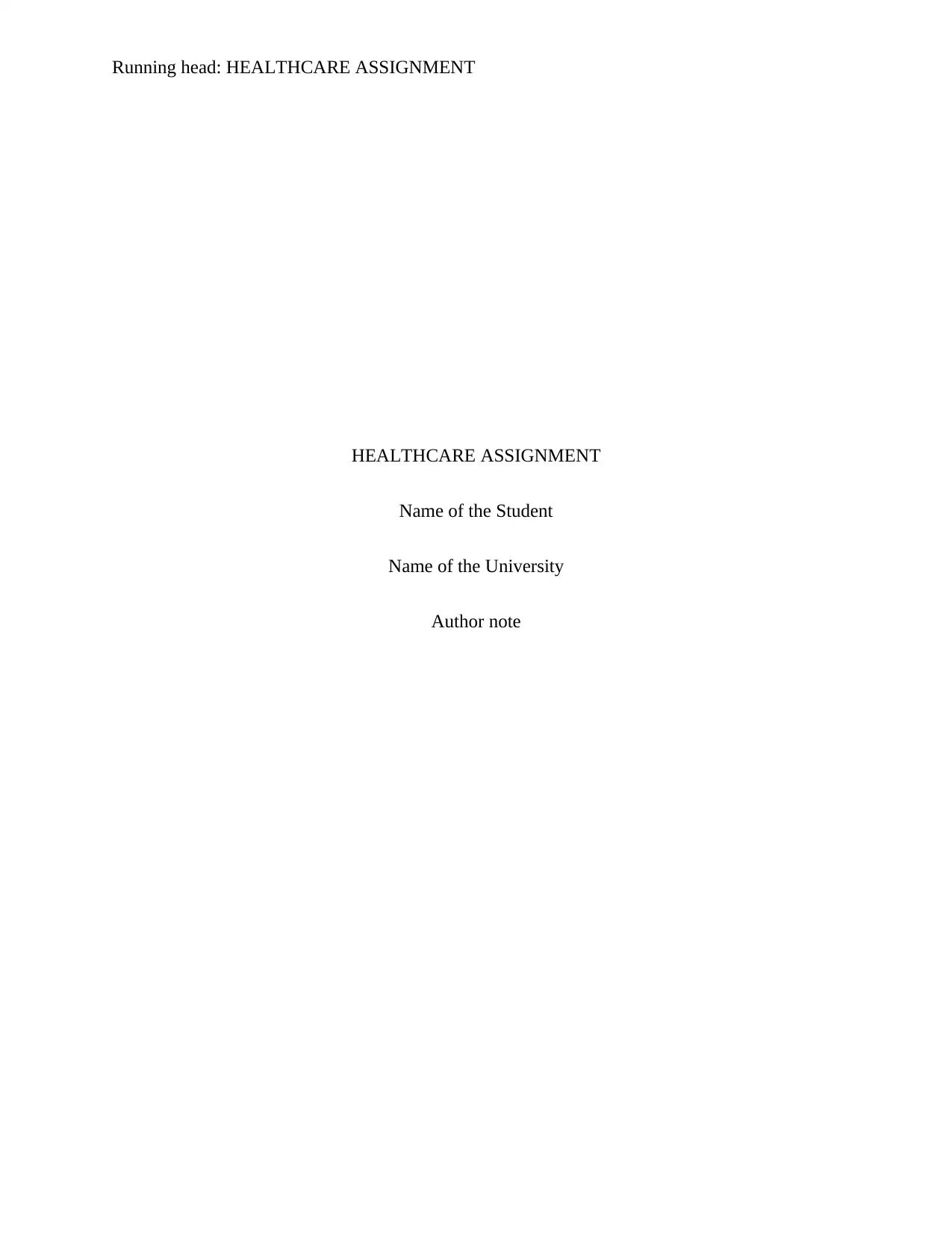
Running head: HEALTHCARE ASSIGNMENT
HEALTHCARE ASSIGNMENT
Name of the Student
Name of the University
Author note
HEALTHCARE ASSIGNMENT
Name of the Student
Name of the University
Author note
Paraphrase This Document
Need a fresh take? Get an instant paraphrase of this document with our AI Paraphraser
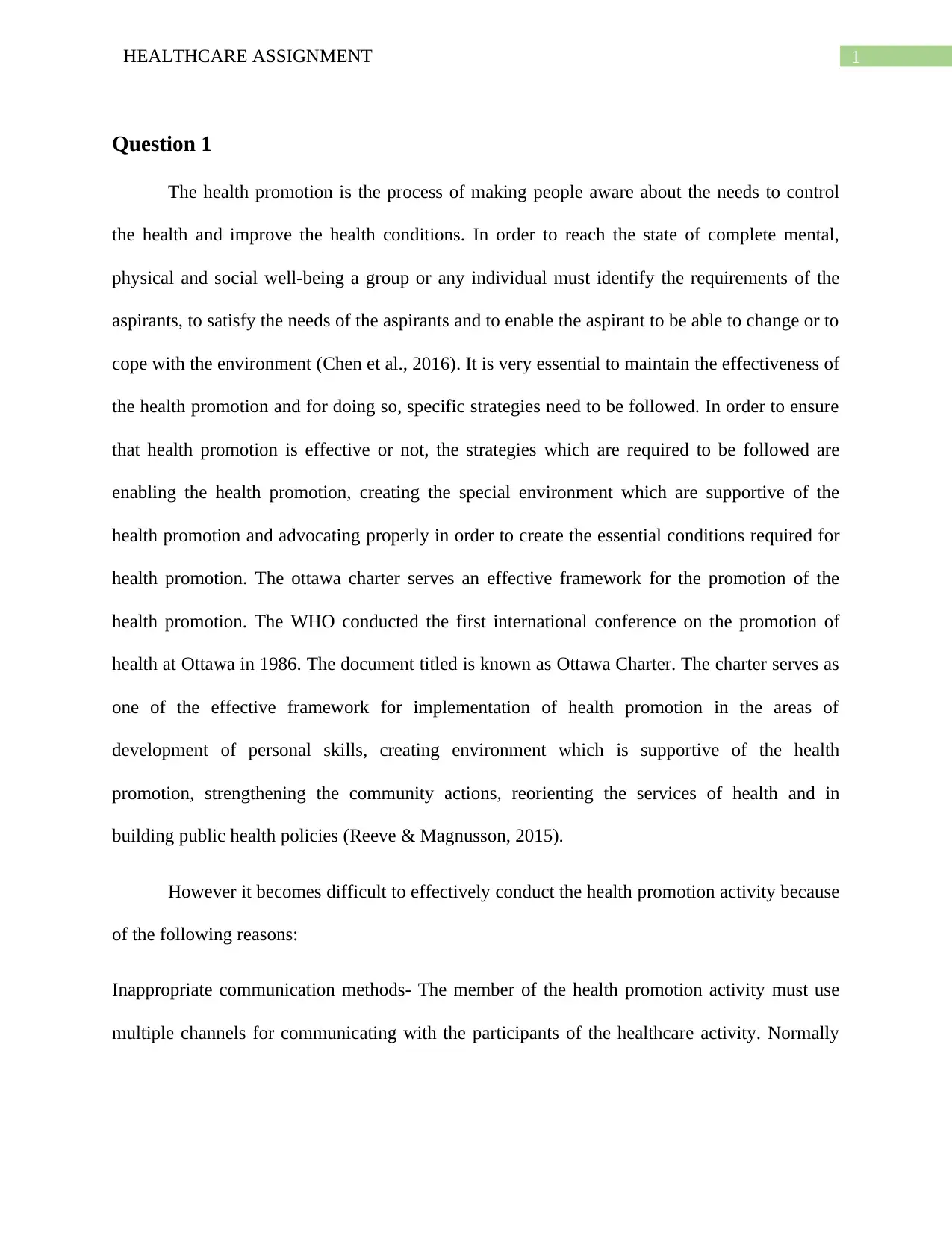
1HEALTHCARE ASSIGNMENT
Question 1
The health promotion is the process of making people aware about the needs to control
the health and improve the health conditions. In order to reach the state of complete mental,
physical and social well-being a group or any individual must identify the requirements of the
aspirants, to satisfy the needs of the aspirants and to enable the aspirant to be able to change or to
cope with the environment (Chen et al., 2016). It is very essential to maintain the effectiveness of
the health promotion and for doing so, specific strategies need to be followed. In order to ensure
that health promotion is effective or not, the strategies which are required to be followed are
enabling the health promotion, creating the special environment which are supportive of the
health promotion and advocating properly in order to create the essential conditions required for
health promotion. The ottawa charter serves an effective framework for the promotion of the
health promotion. The WHO conducted the first international conference on the promotion of
health at Ottawa in 1986. The document titled is known as Ottawa Charter. The charter serves as
one of the effective framework for implementation of health promotion in the areas of
development of personal skills, creating environment which is supportive of the health
promotion, strengthening the community actions, reorienting the services of health and in
building public health policies (Reeve & Magnusson, 2015).
However it becomes difficult to effectively conduct the health promotion activity because
of the following reasons:
Inappropriate communication methods- The member of the health promotion activity must use
multiple channels for communicating with the participants of the healthcare activity. Normally
Question 1
The health promotion is the process of making people aware about the needs to control
the health and improve the health conditions. In order to reach the state of complete mental,
physical and social well-being a group or any individual must identify the requirements of the
aspirants, to satisfy the needs of the aspirants and to enable the aspirant to be able to change or to
cope with the environment (Chen et al., 2016). It is very essential to maintain the effectiveness of
the health promotion and for doing so, specific strategies need to be followed. In order to ensure
that health promotion is effective or not, the strategies which are required to be followed are
enabling the health promotion, creating the special environment which are supportive of the
health promotion and advocating properly in order to create the essential conditions required for
health promotion. The ottawa charter serves an effective framework for the promotion of the
health promotion. The WHO conducted the first international conference on the promotion of
health at Ottawa in 1986. The document titled is known as Ottawa Charter. The charter serves as
one of the effective framework for implementation of health promotion in the areas of
development of personal skills, creating environment which is supportive of the health
promotion, strengthening the community actions, reorienting the services of health and in
building public health policies (Reeve & Magnusson, 2015).
However it becomes difficult to effectively conduct the health promotion activity because
of the following reasons:
Inappropriate communication methods- The member of the health promotion activity must use
multiple channels for communicating with the participants of the healthcare activity. Normally
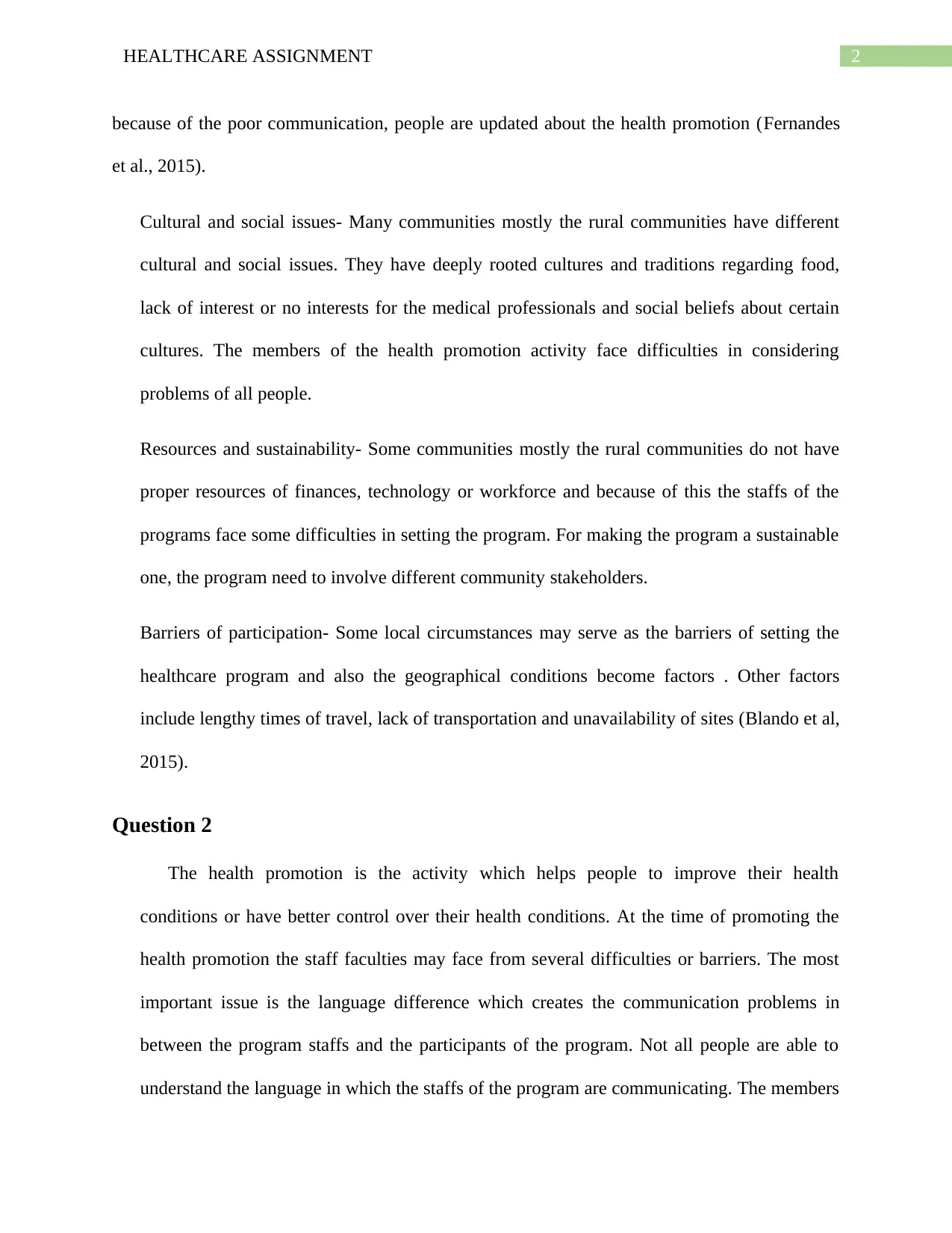
2HEALTHCARE ASSIGNMENT
because of the poor communication, people are updated about the health promotion (Fernandes
et al., 2015).
Cultural and social issues- Many communities mostly the rural communities have different
cultural and social issues. They have deeply rooted cultures and traditions regarding food,
lack of interest or no interests for the medical professionals and social beliefs about certain
cultures. The members of the health promotion activity face difficulties in considering
problems of all people.
Resources and sustainability- Some communities mostly the rural communities do not have
proper resources of finances, technology or workforce and because of this the staffs of the
programs face some difficulties in setting the program. For making the program a sustainable
one, the program need to involve different community stakeholders.
Barriers of participation- Some local circumstances may serve as the barriers of setting the
healthcare program and also the geographical conditions become factors . Other factors
include lengthy times of travel, lack of transportation and unavailability of sites (Blando et al,
2015).
Question 2
The health promotion is the activity which helps people to improve their health
conditions or have better control over their health conditions. At the time of promoting the
health promotion the staff faculties may face from several difficulties or barriers. The most
important issue is the language difference which creates the communication problems in
between the program staffs and the participants of the program. Not all people are able to
understand the language in which the staffs of the program are communicating. The members
because of the poor communication, people are updated about the health promotion (Fernandes
et al., 2015).
Cultural and social issues- Many communities mostly the rural communities have different
cultural and social issues. They have deeply rooted cultures and traditions regarding food,
lack of interest or no interests for the medical professionals and social beliefs about certain
cultures. The members of the health promotion activity face difficulties in considering
problems of all people.
Resources and sustainability- Some communities mostly the rural communities do not have
proper resources of finances, technology or workforce and because of this the staffs of the
programs face some difficulties in setting the program. For making the program a sustainable
one, the program need to involve different community stakeholders.
Barriers of participation- Some local circumstances may serve as the barriers of setting the
healthcare program and also the geographical conditions become factors . Other factors
include lengthy times of travel, lack of transportation and unavailability of sites (Blando et al,
2015).
Question 2
The health promotion is the activity which helps people to improve their health
conditions or have better control over their health conditions. At the time of promoting the
health promotion the staff faculties may face from several difficulties or barriers. The most
important issue is the language difference which creates the communication problems in
between the program staffs and the participants of the program. Not all people are able to
understand the language in which the staffs of the program are communicating. The members
⊘ This is a preview!⊘
Do you want full access?
Subscribe today to unlock all pages.

Trusted by 1+ million students worldwide

3HEALTHCARE ASSIGNMENT
of the healthcare programs thus should know the local languages of the community
(Hamberger, Rhodes & Brown, 2015). Working in a team leads to creation of issues, the
issues can be of any matter. It may happen in between the staffs of the program regarding the
management of the program. The social and the cultural barriers also hamper the health
promotion activities. Not all people participating in the health promotion belong from the
same economic background. So different people have different cultural activities an activities
and when they try to force their views on others, issues occur happen.
The next most important aspect of the health care planning are the group of population
who are involved in the program. The participants of the program can be adolescent, adult or
can be an aged person and the disease of the healthcare program can be of any age group. So
the staffs of the healthcare program must communicate with the participants according to the
age group. For example, in a healthcare program of reduction of substance abuse, the
participants can be from school going adolescents to aged person of 55 to 60 years of age.
The reasons for them to consume alcohol are different. Like the school going or the college
going students normally starts drinking because of peer pressure, some people drink because
of work pressure whereas some drink for recreation and some because of personal issues. In
this case, the members of the health program must address all the issues of the participants
(Anderson et al., 2016).
The next most important aspect is the settings of the health promotion. The place where
the health promotion activity would happen must be free from any kind of disturbances so
that the health program can be coordinated satisfactorily. Most of the healthcare programs are
coordinated in educational institutions, workplaces and in some restricted public areas like
hospitals as here health conscious peoples. The setting of the program must be in such area
of the healthcare programs thus should know the local languages of the community
(Hamberger, Rhodes & Brown, 2015). Working in a team leads to creation of issues, the
issues can be of any matter. It may happen in between the staffs of the program regarding the
management of the program. The social and the cultural barriers also hamper the health
promotion activities. Not all people participating in the health promotion belong from the
same economic background. So different people have different cultural activities an activities
and when they try to force their views on others, issues occur happen.
The next most important aspect of the health care planning are the group of population
who are involved in the program. The participants of the program can be adolescent, adult or
can be an aged person and the disease of the healthcare program can be of any age group. So
the staffs of the healthcare program must communicate with the participants according to the
age group. For example, in a healthcare program of reduction of substance abuse, the
participants can be from school going adolescents to aged person of 55 to 60 years of age.
The reasons for them to consume alcohol are different. Like the school going or the college
going students normally starts drinking because of peer pressure, some people drink because
of work pressure whereas some drink for recreation and some because of personal issues. In
this case, the members of the health program must address all the issues of the participants
(Anderson et al., 2016).
The next most important aspect is the settings of the health promotion. The place where
the health promotion activity would happen must be free from any kind of disturbances so
that the health program can be coordinated satisfactorily. Most of the healthcare programs are
coordinated in educational institutions, workplaces and in some restricted public areas like
hospitals as here health conscious peoples. The setting of the program must be in such area
Paraphrase This Document
Need a fresh take? Get an instant paraphrase of this document with our AI Paraphraser

4HEALTHCARE ASSIGNMENT
where many people can gather and participate in the program effectively. The setting must be
free from any king of unwanted disturbances (Pilotto et al., 2017).
Question 3
The community health assessments, also called as the community health needs
assignment refers to the state, local, tribal or the territorial health assessments which
identifies the essential needs of the community by the help of collecting data systematically
and comprehensively. The community assessment has been considered to be very critical
because broad, proactive and diverse communities are involved for improving the results. It
provides a significant area where interventions are taken according to the populations
involved and so chances are there for the interventions to get hampered. So it is really
difficult to consider all the requirements and needs to implement the healthcare programs
(Craig et al., 2017).
The types of needs can be classified into the following –
Physiological needs – These refers to the needs which are very essential to lead the life which
involves food, clothing, shelter, water, air and sleep. The activities of the human beings will
not be satisfied if these needs are not fulfilled.
Safety needs- The safety needs takes the place like the safety of job, insurance plan, safety
for older age.
Social needs- The social needs involves the needs for love, affection, friendship and
acceptance of the group. A man is also a social being and needs love and care to live happily.
It also means creation of meaningful relationships with others.
where many people can gather and participate in the program effectively. The setting must be
free from any king of unwanted disturbances (Pilotto et al., 2017).
Question 3
The community health assessments, also called as the community health needs
assignment refers to the state, local, tribal or the territorial health assessments which
identifies the essential needs of the community by the help of collecting data systematically
and comprehensively. The community assessment has been considered to be very critical
because broad, proactive and diverse communities are involved for improving the results. It
provides a significant area where interventions are taken according to the populations
involved and so chances are there for the interventions to get hampered. So it is really
difficult to consider all the requirements and needs to implement the healthcare programs
(Craig et al., 2017).
The types of needs can be classified into the following –
Physiological needs – These refers to the needs which are very essential to lead the life which
involves food, clothing, shelter, water, air and sleep. The activities of the human beings will
not be satisfied if these needs are not fulfilled.
Safety needs- The safety needs takes the place like the safety of job, insurance plan, safety
for older age.
Social needs- The social needs involves the needs for love, affection, friendship and
acceptance of the group. A man is also a social being and needs love and care to live happily.
It also means creation of meaningful relationships with others.
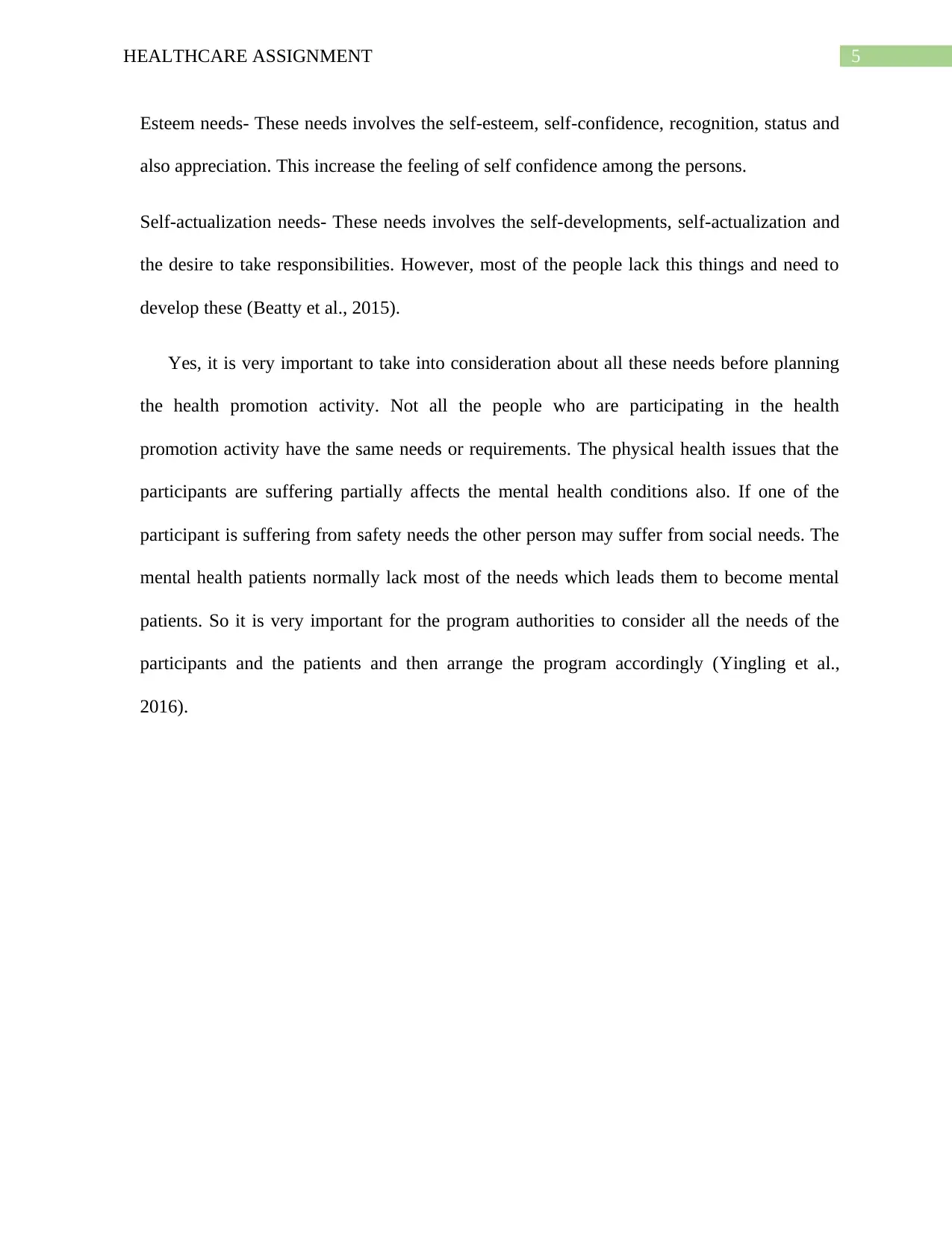
5HEALTHCARE ASSIGNMENT
Esteem needs- These needs involves the self-esteem, self-confidence, recognition, status and
also appreciation. This increase the feeling of self confidence among the persons.
Self-actualization needs- These needs involves the self-developments, self-actualization and
the desire to take responsibilities. However, most of the people lack this things and need to
develop these (Beatty et al., 2015).
Yes, it is very important to take into consideration about all these needs before planning
the health promotion activity. Not all the people who are participating in the health
promotion activity have the same needs or requirements. The physical health issues that the
participants are suffering partially affects the mental health conditions also. If one of the
participant is suffering from safety needs the other person may suffer from social needs. The
mental health patients normally lack most of the needs which leads them to become mental
patients. So it is very important for the program authorities to consider all the needs of the
participants and the patients and then arrange the program accordingly (Yingling et al.,
2016).
Esteem needs- These needs involves the self-esteem, self-confidence, recognition, status and
also appreciation. This increase the feeling of self confidence among the persons.
Self-actualization needs- These needs involves the self-developments, self-actualization and
the desire to take responsibilities. However, most of the people lack this things and need to
develop these (Beatty et al., 2015).
Yes, it is very important to take into consideration about all these needs before planning
the health promotion activity. Not all the people who are participating in the health
promotion activity have the same needs or requirements. The physical health issues that the
participants are suffering partially affects the mental health conditions also. If one of the
participant is suffering from safety needs the other person may suffer from social needs. The
mental health patients normally lack most of the needs which leads them to become mental
patients. So it is very important for the program authorities to consider all the needs of the
participants and the patients and then arrange the program accordingly (Yingling et al.,
2016).
⊘ This is a preview!⊘
Do you want full access?
Subscribe today to unlock all pages.

Trusted by 1+ million students worldwide
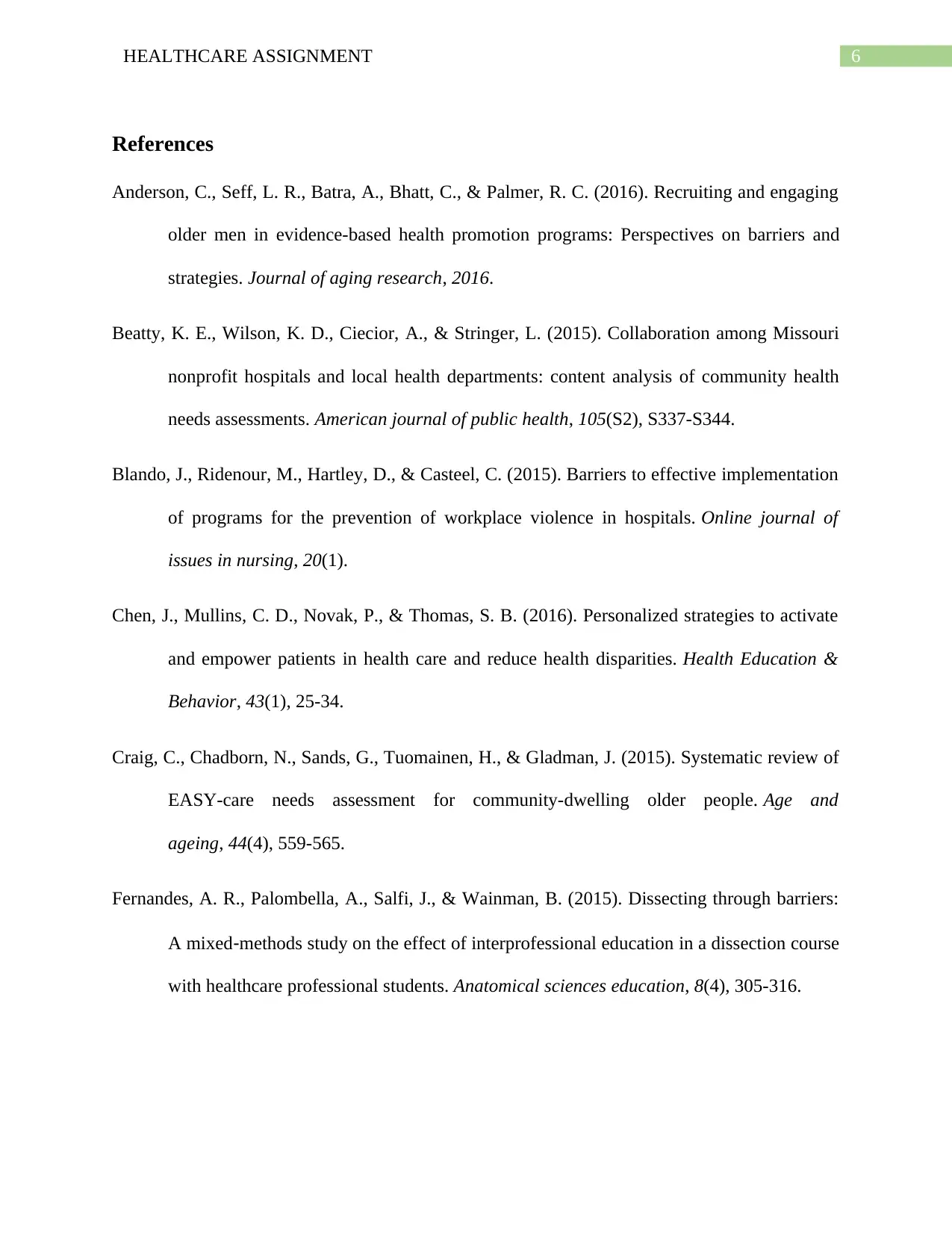
6HEALTHCARE ASSIGNMENT
References
Anderson, C., Seff, L. R., Batra, A., Bhatt, C., & Palmer, R. C. (2016). Recruiting and engaging
older men in evidence-based health promotion programs: Perspectives on barriers and
strategies. Journal of aging research, 2016.
Beatty, K. E., Wilson, K. D., Ciecior, A., & Stringer, L. (2015). Collaboration among Missouri
nonprofit hospitals and local health departments: content analysis of community health
needs assessments. American journal of public health, 105(S2), S337-S344.
Blando, J., Ridenour, M., Hartley, D., & Casteel, C. (2015). Barriers to effective implementation
of programs for the prevention of workplace violence in hospitals. Online journal of
issues in nursing, 20(1).
Chen, J., Mullins, C. D., Novak, P., & Thomas, S. B. (2016). Personalized strategies to activate
and empower patients in health care and reduce health disparities. Health Education &
Behavior, 43(1), 25-34.
Craig, C., Chadborn, N., Sands, G., Tuomainen, H., & Gladman, J. (2015). Systematic review of
EASY-care needs assessment for community-dwelling older people. Age and
ageing, 44(4), 559-565.
Fernandes, A. R., Palombella, A., Salfi, J., & Wainman, B. (2015). Dissecting through barriers:
A mixed‐methods study on the effect of interprofessional education in a dissection course
with healthcare professional students. Anatomical sciences education, 8(4), 305-316.
References
Anderson, C., Seff, L. R., Batra, A., Bhatt, C., & Palmer, R. C. (2016). Recruiting and engaging
older men in evidence-based health promotion programs: Perspectives on barriers and
strategies. Journal of aging research, 2016.
Beatty, K. E., Wilson, K. D., Ciecior, A., & Stringer, L. (2015). Collaboration among Missouri
nonprofit hospitals and local health departments: content analysis of community health
needs assessments. American journal of public health, 105(S2), S337-S344.
Blando, J., Ridenour, M., Hartley, D., & Casteel, C. (2015). Barriers to effective implementation
of programs for the prevention of workplace violence in hospitals. Online journal of
issues in nursing, 20(1).
Chen, J., Mullins, C. D., Novak, P., & Thomas, S. B. (2016). Personalized strategies to activate
and empower patients in health care and reduce health disparities. Health Education &
Behavior, 43(1), 25-34.
Craig, C., Chadborn, N., Sands, G., Tuomainen, H., & Gladman, J. (2015). Systematic review of
EASY-care needs assessment for community-dwelling older people. Age and
ageing, 44(4), 559-565.
Fernandes, A. R., Palombella, A., Salfi, J., & Wainman, B. (2015). Dissecting through barriers:
A mixed‐methods study on the effect of interprofessional education in a dissection course
with healthcare professional students. Anatomical sciences education, 8(4), 305-316.
Paraphrase This Document
Need a fresh take? Get an instant paraphrase of this document with our AI Paraphraser
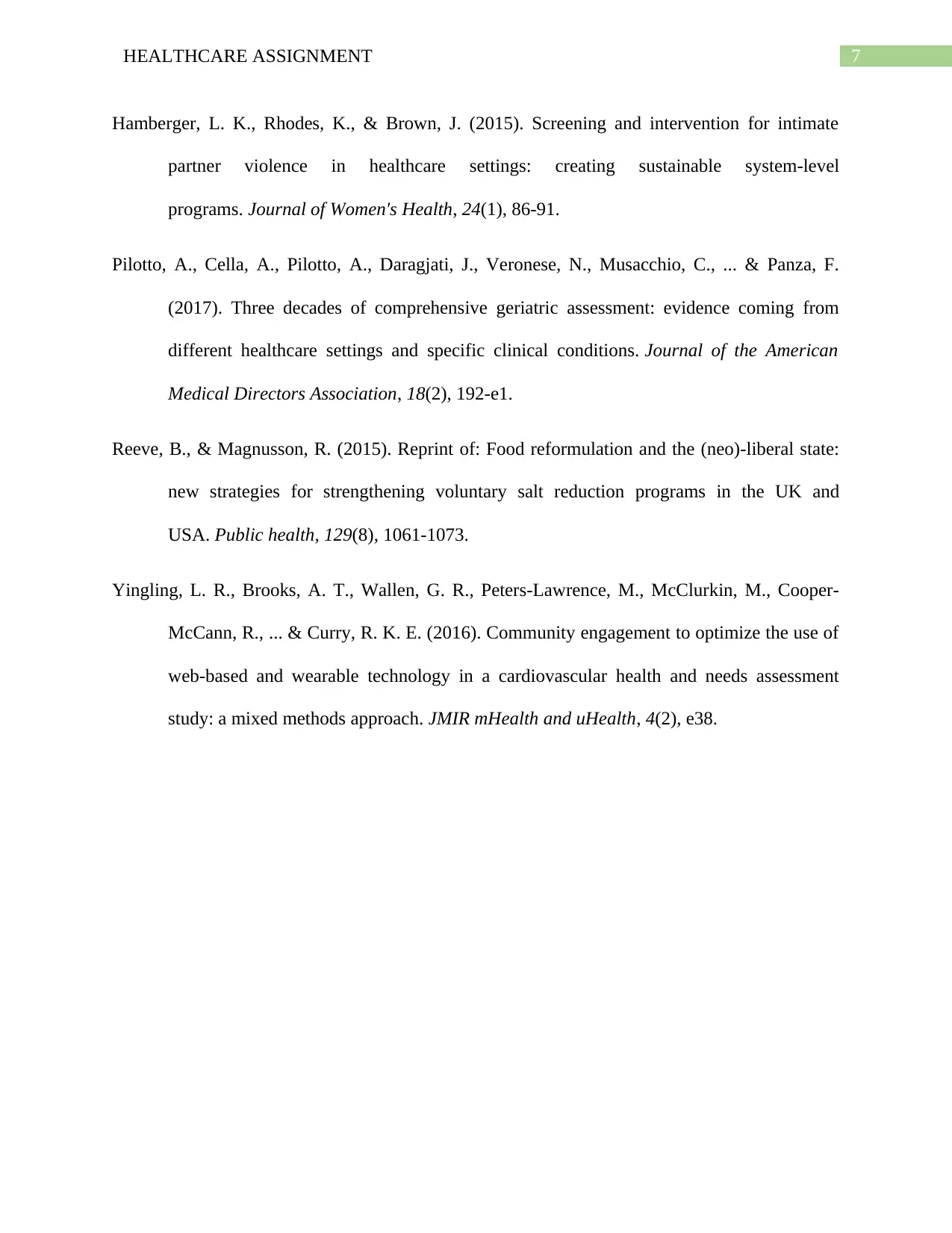
7HEALTHCARE ASSIGNMENT
Hamberger, L. K., Rhodes, K., & Brown, J. (2015). Screening and intervention for intimate
partner violence in healthcare settings: creating sustainable system-level
programs. Journal of Women's Health, 24(1), 86-91.
Pilotto, A., Cella, A., Pilotto, A., Daragjati, J., Veronese, N., Musacchio, C., ... & Panza, F.
(2017). Three decades of comprehensive geriatric assessment: evidence coming from
different healthcare settings and specific clinical conditions. Journal of the American
Medical Directors Association, 18(2), 192-e1.
Reeve, B., & Magnusson, R. (2015). Reprint of: Food reformulation and the (neo)-liberal state:
new strategies for strengthening voluntary salt reduction programs in the UK and
USA. Public health, 129(8), 1061-1073.
Yingling, L. R., Brooks, A. T., Wallen, G. R., Peters-Lawrence, M., McClurkin, M., Cooper-
McCann, R., ... & Curry, R. K. E. (2016). Community engagement to optimize the use of
web-based and wearable technology in a cardiovascular health and needs assessment
study: a mixed methods approach. JMIR mHealth and uHealth, 4(2), e38.
Hamberger, L. K., Rhodes, K., & Brown, J. (2015). Screening and intervention for intimate
partner violence in healthcare settings: creating sustainable system-level
programs. Journal of Women's Health, 24(1), 86-91.
Pilotto, A., Cella, A., Pilotto, A., Daragjati, J., Veronese, N., Musacchio, C., ... & Panza, F.
(2017). Three decades of comprehensive geriatric assessment: evidence coming from
different healthcare settings and specific clinical conditions. Journal of the American
Medical Directors Association, 18(2), 192-e1.
Reeve, B., & Magnusson, R. (2015). Reprint of: Food reformulation and the (neo)-liberal state:
new strategies for strengthening voluntary salt reduction programs in the UK and
USA. Public health, 129(8), 1061-1073.
Yingling, L. R., Brooks, A. T., Wallen, G. R., Peters-Lawrence, M., McClurkin, M., Cooper-
McCann, R., ... & Curry, R. K. E. (2016). Community engagement to optimize the use of
web-based and wearable technology in a cardiovascular health and needs assessment
study: a mixed methods approach. JMIR mHealth and uHealth, 4(2), e38.
1 out of 8
Related Documents
Your All-in-One AI-Powered Toolkit for Academic Success.
+13062052269
info@desklib.com
Available 24*7 on WhatsApp / Email
![[object Object]](/_next/static/media/star-bottom.7253800d.svg)
Unlock your academic potential
Copyright © 2020–2025 A2Z Services. All Rights Reserved. Developed and managed by ZUCOL.





